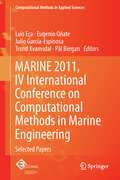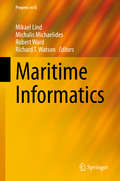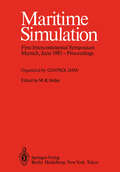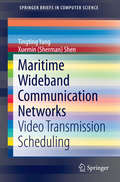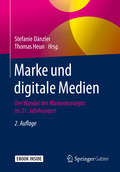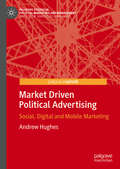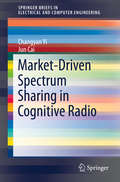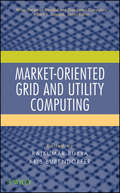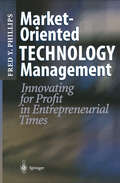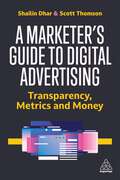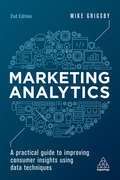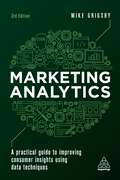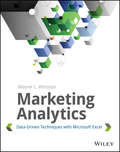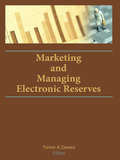- Table View
- List View
MARINE 2011, IV International Conference on Computational Methods in Marine Engineering: Selected Papers (Computational Methods in Applied Sciences #29)
by Luís Eça, Eugenio Oñate, Julio García-Espinosa, Trond Kvamsdal and Pål BerganThis book contains selected papers from the Fourth International Conference on Computational Methods in Marine Engineering, held at Instituto Superior Técnico, Technical University of Lisbon, Portugal in September 2011. Nowadays, computational methods are an essential tool of engineering, which includes a major field of interest in marine applications, such as the maritime and offshore industries and engineering challenges related to the marine environment and renewable energies. The 2011 Conference included 8 invited plenary lectures and 86 presentations distributed through 10 thematic sessions that covered many of the most relevant topics of marine engineering today. This book contains 16 selected papers from the Conference that cover “CFD for Offshore Applications”, “Fluid-Structure Interaction”, “Isogeometric Methods for Marine Engineering”, “Marine/Offshore Renewable Energy”, “Maneuvering and Seakeeping”, “Propulsion and Cavitation” and “Ship Hydrodynamics”. The papers were selected with the help of the recognized experts that collaborated in the organization of the thematic sessions of the Conference, which guarantees the high quality of the papers included in this book.
Maritime Informatics (Progress in IS)
by Mikael Lind Michalis Michaelides Robert Ward Richard T. WatsonThis first book on Maritime Informatics describes the potential for Maritime Informatics to enhance the shipping industry. It examines how decision making in the industry can be improved by digital technology, and introduces the technology required to make Maritime Informatics a distinct and valuable discipline. Based on participating in EU funded research over the last six years to improve the shipping industry, the editors stipulate that there is a need for the new discipline of Maritime Informatics, which studies the application of information systems to increasing the efficiency, safety, and ecological sustainability of the world’s shipping industry. This book examines competition and collaboration between shipping companies, and also companies who serve shipping needs, such as ports and terminals. Practical examples from leading experts give the reader real world examples for better understanding.
Maritime Security: Protection of Marinas, Ports, Small Watercraft, Yachts, and Ships
by Ph.D, Daniel BennyIn a time when threats against the maritime community have never been greater, Maritime Security: Protection of Marinas, Ports, Small Watercraft, Yachts, and Ships provides a single, comprehensive source of necessary information for understanding and preventing or reducing threats to the maritime community.The book defines what comprises the mariti
Maritime Security: Protection of Marinas, Ports, Small Watercraft, Yachts, and Ships
by Ph.D, Daniel BennyIn a time when threats against the maritime community have never been greater, Maritime Security: Protection of Marinas, Ports, Small Watercraft, Yachts, and Ships provides a single, comprehensive source of necessary information for understanding and preventing or reducing threats to the maritime community.The book defines what comprises the mariti
Maritime Simulation: Proceedings of the First Intercontinental Symposium, Munich, June 1985
by Moshe R. HellerWelcome to Bavaria - Germany and to the First Intercontinental Maritime Simulation Symposium and Mathematical Modelling Workshop. A triennial international conference jointly pro moted by Control Data, IMSF and SCS, which takes place at Schliersee, a small town near the Alps. The aim of the Symposium is to cover most of the aspects of maritime modelling and simulation in theory and practice, to promote the exchange of knowledge and experience between dif ferent international research groups in this field, and to strengthen the international contact between developers and users of modelling and simulation techniques. On the occas~on of the Symposium people of scientific and engineering disciplines will meet to discuss the state-of-the art and future activities and developments. A large number of contributed papers has been strictly exam ined and selected by the papers committee to guarantee a high international standard. The book contains the accepted papers which will be presented at the Symposium. The papers have been classified according to the following topics: VI 1. Fifth Generation Computer Technology 2. Simulation-Software-Tools 3. An Industrial Computer System - The Chrysler Story 4. Marine Mathematical Modelling 5. CFD for Marine Vehicles 6. Navigation Methodology 7. Marine Maneuvering and Motion Simulation 8. Off-Shore Modelling 9. Steering and Control of Marine Vehicles 10. Training and Traffic Control 11. Under-Water Vehicles Operation Authors from 9 countries will meet at the Symposium.
Maritime Wideband Communication Networks: Video Transmission Scheduling (SpringerBriefs in Computer Science)
by Tingting Yang Xuemin (Sherman) ShenThis Springer Brief covers emerging maritime wideband communication networks and how they facilitate applications such as maritime distress, urgency, safety and general communications. It provides valuable insight on the data transmission scheduling and protocol design for the maritime wideband network. This brief begins with an introduction to maritime wideband communication networks including the architecture, framework, operations and a comprehensive survey on current developments. The second part of the brief presents the resource allocation and scheduling for video packet transmission with a goal of maximizing the weights of uploaded video packets. Finally, an energy and content aware scheduling scheme is proposed for the most efficient vessel packet throughput. Based on the real ship route traces obtained from the navigation software BLM-Ship, simulation results demonstrate the viability of the proposed schemes. Conclusions and further research directions are discussed. Maritime Wideband Communication Networks: Video Transmission Scheduling is a valuable tool for researchers and professionals working in wireless communications and networks. Advanced-level students studying computer science and electrical engineering will also find the content valuable.
Marke und digitale Medien: Der Wandel des Markenkonzepts im 21. Jahrhundert
by Stefanie Dänzler Thomas HeunDie Autoren dieses Buches diskutieren klassische und neuere Konzepte sowie theoretische und operative Ansätze zur Führung von Marken und geben einen Überblick über den aktuellen Stand der Debatten rund um das Konzept der Marke. Renommierte Wissenschaftler unterschiedlicher Disziplinen stellen ihre Forschungserkenntnisse zur Markentheorie dar, und namhafte Praktiker geben Empfehlungen, wie man den aus der Digitalisierung resultierenden Herausforderungen begegnen kann. Denn mit den digitalen Medienangeboten, Übertragungswegen und Endgeräten entstehen immer neue Möglichkeiten der Kommunikation und Interaktion mit den Rezipienten. So kommt es zu einem fundamentalen Medienwandel, der Marken zwingt, sich den digitalen Veränderungen anzupassen. Diese erweiterte Medienlandschaft bietet Marken für ihre Entwicklung, Kommunikation und Distribution neue Möglichkeiten und Chancen. Neben den operativen Herausforderungen stellt sich zunehmend die Frage nach theoretischen Erklärungsansätzen für die Entwicklung und Führung von Marken im digitalen Zeitalter. Das Buch richtet sich an Markenmanager, Produktmanager, Marketingforscher und Werbefachleute, aber auch Dozierende und Studierende der Marketing-, Kommunikations-, Medien- und Sozialwissenschaften lesen es mit Gewinn.In der zweiten Auflage wurden alle Beiträge überarbeitet, neue Beiträge zu den Themen digitale Innovation, Ideenbewertung, Herausforderungen der Markenführung. Big Data und Herausforderungen des Markenmanagements sind hinzugekommen.Der InhaltGrundlagen des Markenkonzepts im 21. JahrhundertsStrategische MarkenführungMarke & DesignSocial MediaEmpirische Studien zur Markenführung
Marken im Metaverse: Chancen und Risiken. Best and Worst Cases. Herausforderungen und Lösungen (essentials)
by Dominik Griese Tom Inden-LohmarDieses essential zeigt, wie strategisch und konzeptionell ein Markenauftritt im Metaverse entwickelt werden muss und was es dafür braucht. Die Vorgehensweise wird an vier realen Beispielen konkret illustriert. Kaum ein Thema wird gerade so kontrovers wie das Web 3.0 und seine Metaversen diskutiert. Täglich wächst die Zahl der Publikationen, Veranstaltungen und Produkte, die sich damit beschäftigen sowie auch die Zahl der Unternehmen, die auf keinen Fall den abfahrenden Zug verpassen wollen. Mindestens genauso groß ist aber die Zahl derer, die das Ganze für sinnlos ausgegebenes Marketingbudget halten. Es wird Zeit, Licht ins Dunkel der unendlichen Weiten des Web 3.0 zu bringen, Grundlagen und Begriffe zu erklären, Wege und Chancen aufzuzeigen, aber auch laut und deutlich vor den Risiken und Fehlern zu warnen.
Marken in der Smart City: Wie die Cyber-Urbanisierung das Marketing verändert
by Alexander GutzmerDieses Buch zeigt Marketern, welche neuen Chancen sich durch die Digitalisierung und die momentan entstehenden Smart Cities für das Marketing ergeben. Alexander Gutzmer fordert dazu auf, Marke, Stadt und Digitalisierung umfassend neu – und zusammen zu denken. Auf Basis eines innovativen Ansatzes und vieler Fallbeispiele aus der Praxis entwirft er das Bild einer digital durchdrungenen Stadt, die Marketing-Entscheidern Antworten auf völlig neue Fragen abverlangt, wenn diese die neuen Chancen für Ihre Marken nutzen wollen.Für Marketing und Markenführung bringt die digitale Erschließung der Stadt zwei zentrale Herausforderungen mit sich: Wie kann der Informations-Reichtum des urbanen Raumes zu neuen, kreativen Markenansätzen inspirieren? Und wie wird dies die Idee der Marken-Positionierung und -Kommunikation insgesamt langfristig verändern?Der Autor liefert Ideen, wie der urbane Raum als Resonanzfläche in Kampagnen integriert werden kann. Treiber dieser neuen Marken-Inszenierung im (öffentlichen) Raum sind die Daten. Analyse und Management dieser Daten ermöglichen es, Marken in Städten kreativ zu inszenieren und mit dem städtischen Raum zu verweben. Das hat Konsequenzen: Die ästhetische Welt der klassischen Werbung kam bislang ohne raue Wirklichkeiten aus. Das geht heute nicht mehr. Die Welt der Daten ist Ästhetik-avers. Sie ist hart, rau, direkt, ehrlich. Wie die Stadt.Der AutorAlexander Gutzmer ist Professor für Kommunikation und Medien an der Quadriga University, Berlin, und Chefredakteur der Architekturzeitschrift Baumeister. Gutzmer ist Diplom-Betriebswirt und promovierter Kulturwissenschaftler.
Marken- und domänenübergreifendes Management industrieller Produktdaten
by Stefan KehlIn diesem Buch stellt Stefan Kehl erstmals ein ganzheitliches Konzept zur technischen Unterstützung durchgängiger Produktentwicklungsprozesse unter Berücksichtigung der Wiederverwendung und transparenten Änderbarkeit von Produktbestandteilen in unternehmensübergreifenden Kollaborationsverbünden vor. Zur Analyse der damit verbundenen Herausforderungen wurde eine Fallstudie bei einem deutschen Automobilhersteller unter Berücksichtigung der Zusammenarbeit der einzelnen Marken durchgeführt. Als Ergebnis wird ein disziplinenübergreifendes Produktmodell vorgeschlagen, das dezentral mit disziplinspezifischen Ergebnissen erweitert werden kann. Die Koordination von Erweiterungen und nachfolgenden Änderungen erfolgt systemübergreifend mittels einer ereignisbasierten Softwarearchitektur.
Market Driven Political Advertising: Social, Digital and Mobile Marketing (Palgrave Studies in Political Marketing and Management)
by Andrew HughesExploring the new era of political advertising beyond television and print, this book focuses on the mediums of the new millennia that are transforming campaigning and communications in political systems around the world. The author illustrates how the use of social, digital and mobile advertising enables political marketers to deliver messages more accurately and strengthen relationships between stakeholders such as voters, supporters and candidates. Examining digital and social media platforms such as Facebook, Twitter and YouTube, this innovative book analyses the changing political marketing landscape and proposes conceptual models for implementing more successful and effective political communications in the future.
Market Driven Political Advertising: Social, Digital and Mobile Marketing (PDF) (Palgrave Studies in Political Marketing and Management)
by Andrew HughesExploring the new era of political advertising beyond television and print, this book focuses on the mediums of the new millennia that are transforming campaigning and communications in political systems around the world. The author illustrates how the use of social, digital and mobile advertising enables political marketers to deliver messages more accurately and strengthen relationships between stakeholders such as voters, supporters and candidates. Examining digital and social media platforms such as Facebook, Twitter and YouTube, this innovative book analyses the changing political marketing landscape and proposes conceptual models for implementing more successful and effective political communications in the future.
Market-Driven Spectrum Sharing in Cognitive Radio (SpringerBriefs in Electrical and Computer Engineering)
by Changyan Yi Jun CaiThis brief focuses on the current research on mechanism design for dynamic spectrum sharing in cognitive radio (CR) networks. Along with a review of CR architectures and characteristics, this brief presents the motivations, significances and unique challenges of implementing algorithmic mechanism design for encouraging both primary spectrum owners and secondary spectrum users to participate in dynamic spectrum sharing. The brief then focuses on recent advances in mechanism design in CR networks. With an emphasis on dealing with the uncertain spectrum availabilities, mechanisms based on spectrum recall, two-stage spectrum sharing and online spectrum allocation are introduced with the support of theoretic analyses and numerical illustrations. The brief concludes with a discussion of potential research directions and interests, which will motivate further studies on mechanism design for wireless communications. This brief is concise and approachable for researchers, professionals and advanced-level students in wireless communications and networks.
Market Engineering: Insights from Two Decades of Research on Markets and Information
This open access book provides a broad range of insights on market engineering and information management. It covers topics like auctions, stock markets, electricity markets, the sharing economy, information and emotions in markets, smart decision-making in cities and other systems, and methodological approaches to conceptual modeling and taxonomy development. Overall, this book is a source of inspiration for everybody working on the vision of advancing the science of engineering markets and managing information for contributing to a bright, sustainable, digital world. Markets are powerful and extremely efficient mechanisms for coordinating individuals’ and organizations’ behavior in a complex, networked economy. Thus, designing, monitoring, and regulating markets is an essential task of today’s society. This task does not only derive from a purely economic point of view. Leveraging market forces can also help to tackle pressing social and environmental challenges. Moreover,markets process, generate, and reveal information. This information is a production factor and a valuable economic asset. In an increasingly digital world, it is more essential than ever to understand the life cycle of information from its creation and distribution to its use. Both markets and the flow of information should not arbitrarily emerge and develop based on individual, profit-driven actors. Instead, they should be engineered to serve best the whole society’s goals. This motivation drives the research fields of market engineering and information management. With this book, the editors and authors honor Professor Dr. Christof Weinhardt for his enormous and ongoing contribution to market engineering and information management research and practice. It was presented to him on the occasion of his sixtieth birthday in April 2021. Thank you very much, Christof, for so many years of cooperation, support, inspiration, and friendship.
Market Operation for Reactive Power Ancillary Service: Design and Analysis with GAMS Code (Springer Tracts in Electrical and Electronics Engineering)
by Devika Jay K. Shanti SwarupThis book provides a framework suitable for the design and analysis of market mechanisms suitable for reactive power ancillary service. The book focuses on the formulation of market mechanisms capable of handling the localized nature of reactive power. The book presents tools and methodologies to design a suitable market structure capable of handling the technical challenges associated with the reactive power market like localized nature or reactive power, voltage support requirement, reactive power reserve requirement, and coupling between active reactive power markets. The book also presents techniques suitable for analyzing the market efficiency of different market mechanisms for reactive power ancillary service. The key topics discussed in this book include the relevance and challenges of reactive power ancillary service; the design of market mechanisms; network partitioning techniques to handle the localized nature of reactive power; and analysis of market mechanisms for market efficiency. This book is helpful for researchers and graduate students to know about recent advances in this area. Practitioners find the book helpful for understanding how technological advances can be put into practice and learning from case studies that bring out practical challenges.
Market-Oriented Grid and Utility Computing (Wiley Series on Parallel and Distributed Computing #75)
by Rajkumar Buyya Kris BubendorferThe first single-source reference covering the state of the art in grid and utility computing economy research This book presents the first integrated, single-source reference on market-oriented grid and utility computing. Divided into four main parts—and with contributions from a panel of experts in the field—it systematically and carefully explores: Foundations—presents the fundamental concepts of market-oriented computing and the issues and challenges in allocating resources in a decentralized computing environment. Business models—covers business models for service providers and brokers supporting different types of distributed applications, as well as business rules-based models for managing virtual organizations and accounting operations and services in grid computing environments. Policies and agreements—introduces policies, agreements, and specifications for the negotiation and establishment of contracts between providers and consumers. It also covers different approaches for resource allocation based on service-level agreements (SLAs) and management of risks associated with SLA violations. Resource allocation and scheduling mechanisms—covers economic models, such as commodity models, reciprocation, auctions, and game theory, and middleware technologies, such as Nimrod/G and Gridbus, for market-oriented grid computing and utility-oriented resource allocation. This book expertly captures the state of the art in the field while also identifying potential research directions and technologies that will facilitate the creation of global commercial grid and utility computing systems. It is an indispensable reference for systems architects, practitioners, developers, new researchers, and graduate students.
Market-Oriented Technology Management: Innovating for Profit in Entrepreneurial Times
by Fred Y. PhillipsThis book develops the fundamentals of technology cycles, technology acquisition, core technology management, and technology policy. These principles enable managers to find, acquire and develop technologies, add value to them, and make profits. Examples taken from high tech companies illustrate the application of these principles in the context of current industry issues. The book has been tested on students undertaking MBA courses at Austins Technology Incubator, Texas, and on managers and executives at Oregons Silicon Forest.The books emphasis on marketing is a distinctive feature.
A Marketer's Guide to Digital Advertising: Transparency, Metrics, and Money
by Shailin Dhar Scott ThomsonHow can individual marketers and their teams navigate the complex issues that seem to overwhelm the digital advertising industry today? They can learn about the metrics worth using, the importance of measurement and the technology available. With contradictory rules surrounding data privacy, measurement constraints, changes to supply chains and other complexities often too difficult to approach, the world of marketing is more complex than ever before. A Marketer's Guide to Digital Advertising helps marketers navigate the complicated world of digital advertising by diving into the metrics, money and technology fueling the marketing industry. Digital advertising consultants Shailin Dhar and Scott Thomson outline the forces shaping the current digital landscape and the common responses from advertisers trying to design their digital strategy. Walking readers through the common missteps made within digital advertising, they provide useful insight into measurement and thoughtful alternatives to practices often found lower on a company's priorities list. A Marketer's Guide to Digital Advertising offers ways to minimize waste and improve outcomes for brands and their business partners. The book illuminates the gap between in-house marketing teams, agency professionals and tech partners whilst helping readers make sense of the way money flows through the global ad industry.
Marketing Analytics: A Practical Guide to Improving Consumer Insights Using Data Techniques (Marketing Science Ser.)
by Mike GrigsbyWho is most likely to buy and what is the best way to target them? How can businesses improve strategy without identifying the key influencing factors? The second edition of Marketing Analytics enables marketers and business analysts to leverage predictive techniques to measure and improve performance. By exploring real-world marketing challenges, it provides clear, jargon-free explanations on how to apply different analytical models for each purpose. From targeted list creation and data segmentation, to testing campaign effectiveness, pricing structures and forecasting demand, this book offers a welcome handbook on how statistics, consumer analytics and modelling can be put to optimal use. The fully revised second edition of Marketing Analytics includes three new chapters on big data analytics, insights and panel regression, including how to collect, separate and analyze big data. All of the advanced tools and techniques for predictive analytics have been updated, translating models such as tobit analysis for customer lifetime value into everyday use. Whether an experienced practitioner or having no prior knowledge, methodologies are simplified to ensure the more complex aspects of data and analytics are fully accessible for any level of application. Complete with downloadable data sets and test bank resources, this book supplies a concrete foundation to optimize marketing analytics for day-to-day business advantage.
Marketing Analytics: A Practical Guide to Improving Consumer Insights Using Data Techniques
by Mike GrigsbyWho is most likely to buy and what is the best way to target them? How can businesses improve strategy without identifying the key influencing factors? The second edition of Marketing Analytics enables marketers and business analysts to leverage predictive techniques to measure and improve performance. By exploring real-world marketing challenges, it provides clear, jargon-free explanations on how to apply different analytical models for each purpose. From targeted list creation and data segmentation, to testing campaign effectiveness, pricing structures and forecasting demand, this book offers a welcome handbook on how statistics, consumer analytics and modelling can be put to optimal use. The fully revised second edition of Marketing Analytics includes three new chapters on big data analytics, insights and panel regression, including how to collect, separate and analyze big data. All of the advanced tools and techniques for predictive analytics have been updated, translating models such as tobit analysis for customer lifetime value into everyday use. Whether an experienced practitioner or having no prior knowledge, methodologies are simplified to ensure the more complex aspects of data and analytics are fully accessible for any level of application. Complete with downloadable data sets and test bank resources, this book supplies a concrete foundation to optimize marketing analytics for day-to-day business advantage.
Marketing Analytics: A Practical Guide to Improving Consumer Insights Using Data Techniques (Marketing Science Ser.)
by Mike GrigsbyWho is most likely to buy and what is the best way to target them? How can I use both consumer analytics and modelling to improve the impact of marketing campaigns? Marketing Analytics takes you step-by-step through these areas and more. Marketing Analytics enables you to leverage predictive techniques to measure and improve marketing performance. By exploring real-world marketing challenges, it provides clear, jargon-free explanations on how to apply different analytical models for each purpose. From targeted list creation and data segmentation, to testing campaign effectiveness, pricing structures and forecasting demand, it offers a complete resource for how statistics, consumer analytics and modelling can be put to optimal use. This revised and updated third edition of Marketing Analytics contains new material on forecasting, customer touchpoints modelling, and a new focus on customer loyalty. With accessible language throughout, methodologies are simplified to ensure the more complex aspects of data and analytics are fully accessible for any level of application. Supported by a glossary of key terms and supporting resources consisting of datasets, presentation slides for each chapter and a test bank of self-test question, this book supplies a concrete foundation for optimizing marketing analytics for day-to-day business advantage.
Marketing Analytics: Data-Driven Techniques with Microsoft Excel
by Wayne L. WinstonHelping tech-savvy marketers and data analysts solve real-world business problems with Excel Using data-driven business analytics to understand customers and improve results is a great idea in theory, but in today's busy offices, marketers and analysts need simple, low-cost ways to process and make the most of all that data. This expert book offers the perfect solution. Written by data analysis expert Wayne L. Winston, this practical resource shows you how to tap a simple and cost-effective tool, Microsoft Excel, to solve specific business problems using powerful analytic techniques—and achieve optimum results. Practical exercises in each chapter help you apply and reinforce techniques as you learn. Shows you how to perform sophisticated business analyses using the cost-effective and widely available Microsoft Excel instead of expensive, proprietary analytical tools Reveals how to target and retain profitable customers and avoid high-risk customers Helps you forecast sales and improve response rates for marketing campaigns Explores how to optimize price points for products and services, optimize store layouts, and improve online advertising Covers social media, viral marketing, and how to exploit both effectively Improve your marketing results with Microsoft Excel and the invaluable techniques and ideas in Marketing Analytics: Data-Driven Techniques with Microsoft Excel.
Marketing Analytics: Data-Driven Techniques with Microsoft Excel
by Wayne L. WinstonHelping tech-savvy marketers and data analysts solve real-world business problems with Excel Using data-driven business analytics to understand customers and improve results is a great idea in theory, but in today's busy offices, marketers and analysts need simple, low-cost ways to process and make the most of all that data. This expert book offers the perfect solution. Written by data analysis expert Wayne L. Winston, this practical resource shows you how to tap a simple and cost-effective tool, Microsoft Excel, to solve specific business problems using powerful analytic techniques—and achieve optimum results. Practical exercises in each chapter help you apply and reinforce techniques as you learn. Shows you how to perform sophisticated business analyses using the cost-effective and widely available Microsoft Excel instead of expensive, proprietary analytical tools Reveals how to target and retain profitable customers and avoid high-risk customers Helps you forecast sales and improve response rates for marketing campaigns Explores how to optimize price points for products and services, optimize store layouts, and improve online advertising Covers social media, viral marketing, and how to exploit both effectively Improve your marketing results with Microsoft Excel and the invaluable techniques and ideas in Marketing Analytics: Data-Driven Techniques with Microsoft Excel.
Marketing and Managing Electronic Reserves
by Trevor A. DawesGet practical solutions to the problems faced when implementing an electronic reserve service!Academic libraries that provide electronic reserve services offer convenient access to information to their students and faculty while gaining numerous other advantages, such as reducing both loss and staff workload. Marketing and Managing Electronic Reserves presents leading authorities with practical solutions to the challenges in effectively integrating electronic reserves services and marketing them to users. This book provides positive approaches that any academic library considering the implementation of an electronic reserve operation can use. All factors are considered, including size of institution, the relationship between the library and academic departments, and the budget and plan for marketing the service.More and more colleges and universities are implementing distance education programs, highlighting the increasing need for remote access to information in the library, including reserve material. But executing monumental change is always difficult. Marketing and Managing Electronic Reserves tackles the difficult issues, discussing various libraries&’ journeys in bringing about the changes needed to remain the central information source for students and faculty. Problems inherent in the evolution from traditional reserve services to electronic reserves are examined, offering effective strategies for smooth transition. Whatever type of system you are considering, from homegrown to commercial to hybrid electronic reserves service, this book can help. Marketing and Managing Electronic Reserves explains how others tackled challenges, such as: implementing Endeavor&’s Voyager Integrated Library System and the software used for authenticating users handling copyright compliance integration of electronic reserves into course management systems moving from a paper-based to a Web-based course reserve system offering and marketing one-stop teaching support to faculty a large institution&’s shift to a collaborative approach with electronic reserves and course management software establishing a suite of electronic utilities that fulfills teaching and essential learning activities implementing the Blackboard Content System marketing for a smooth transition from traditional to electronic reserves marketing to the faculty process improvement technique applied to electronic reserves integration of electronic reserve with a Library Management System and Course Management System trends for the futureMarketing and Managing Electronic Reserves is crucial reading for access services librarians, circulation and reserve librarians, public service librarians, library school faculty who teach public services courses, integrated library systems managers, and university course management software specialists.
Marketing and Managing Electronic Reserves
by Trevor A. DawesGet practical solutions to the problems faced when implementing an electronic reserve service!Academic libraries that provide electronic reserve services offer convenient access to information to their students and faculty while gaining numerous other advantages, such as reducing both loss and staff workload. Marketing and Managing Electronic Reserves presents leading authorities with practical solutions to the challenges in effectively integrating electronic reserves services and marketing them to users. This book provides positive approaches that any academic library considering the implementation of an electronic reserve operation can use. All factors are considered, including size of institution, the relationship between the library and academic departments, and the budget and plan for marketing the service.More and more colleges and universities are implementing distance education programs, highlighting the increasing need for remote access to information in the library, including reserve material. But executing monumental change is always difficult. Marketing and Managing Electronic Reserves tackles the difficult issues, discussing various libraries&’ journeys in bringing about the changes needed to remain the central information source for students and faculty. Problems inherent in the evolution from traditional reserve services to electronic reserves are examined, offering effective strategies for smooth transition. Whatever type of system you are considering, from homegrown to commercial to hybrid electronic reserves service, this book can help. Marketing and Managing Electronic Reserves explains how others tackled challenges, such as: implementing Endeavor&’s Voyager Integrated Library System and the software used for authenticating users handling copyright compliance integration of electronic reserves into course management systems moving from a paper-based to a Web-based course reserve system offering and marketing one-stop teaching support to faculty a large institution&’s shift to a collaborative approach with electronic reserves and course management software establishing a suite of electronic utilities that fulfills teaching and essential learning activities implementing the Blackboard Content System marketing for a smooth transition from traditional to electronic reserves marketing to the faculty process improvement technique applied to electronic reserves integration of electronic reserve with a Library Management System and Course Management System trends for the futureMarketing and Managing Electronic Reserves is crucial reading for access services librarians, circulation and reserve librarians, public service librarians, library school faculty who teach public services courses, integrated library systems managers, and university course management software specialists.
